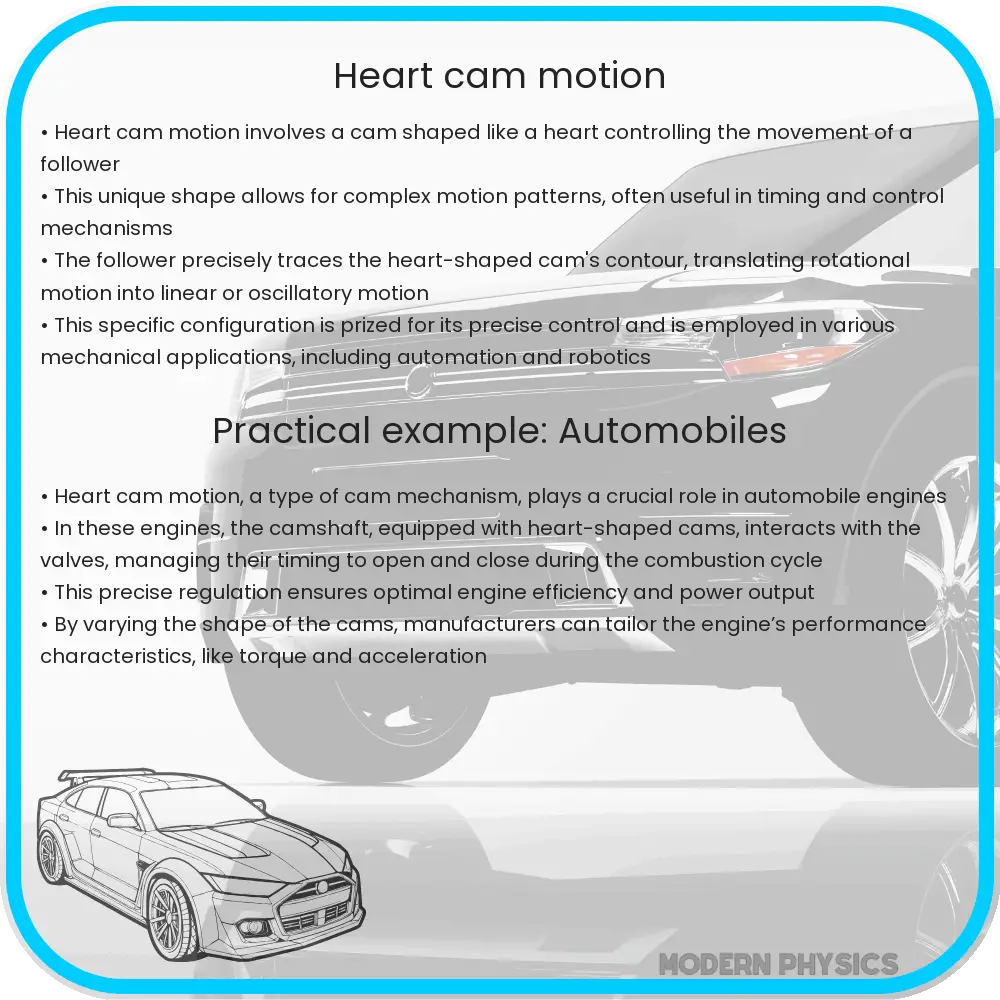Explore the innovative Heart Cam Motion mechanism, its efficiency, precision in various industries, and its impact on sustainability and design.

Exploring the Heart Cam Motion: A Blend of Efficiency, Precision, and Innovative Design
The realm of mechanical engineering is continually evolving, and one of the most intriguing developments in recent times is the Heart Cam Motion mechanism. This advanced concept has garnered attention for its unique blend of efficiency, precision, and design. In this article, we delve into the intricacies of Heart Cam Motion, exploring how it revolutionizes mechanical applications.
Understanding Heart Cam Motion
At its core, the Heart Cam Motion mechanism is a specialized cam system designed to convert rotational motion into linear motion. Unlike traditional cam systems, the Heart Cam features a heart-shaped curve, which is mathematically derived for optimal performance. This shape ensures smoother motion, reduces wear and tear, and provides greater control over the movement of the follower mechanism.
Efficiency: A Core Advantage
One of the standout features of Heart Cam Motion is its efficiency. The unique heart-shaped profile reduces friction and energy loss during operation. This means that machines using Heart Cam Motion require less energy to perform the same tasks as those using conventional cam systems, leading to significant energy savings and reduced operational costs.
Precision in Motion
Precision is another hallmark of the Heart Cam Motion. The heart-shaped cam allows for more accurate control over the follower’s movement. This precision is particularly beneficial in applications requiring intricate movements, such as in robotics, automated assembly lines, and high-precision machinery. The ability to achieve exact positioning with minimal error enhances the overall performance and reliability of the equipment.
Innovative Design
The design of the Heart Cam Motion is not only functional but also aesthetically pleasing. Its heart-shaped profile is not just a mathematical marvel; it also adds a visually appealing element to machinery. This aspect is increasingly important in modern engineering, where the design is as valued as functionality.
Incorporating this innovative mechanism into various applications presents opportunities for engineers and designers alike to push the boundaries of what is possible in mechanical design.
Applications Across Industries
The versatility of the Heart Cam Motion makes it applicable in numerous industries. From automotive to manufacturing, and even in medical devices, its integration promises enhanced efficiency, precision, and a blend of form and function. The following section will further explore these applications, showcasing the widespread impact of this remarkable mechanism.
Diverse Applications of Heart Cam Motion
The adaptability of Heart Cam Motion extends across various sectors. In the automotive industry, it can revolutionize engine valve control, leading to smoother engine performance and increased fuel efficiency. In manufacturing, especially in CNC machines and robotics, it allows for precise control, enhancing product quality and reducing waste. Medical devices, particularly those requiring controlled motion like surgical robots, also benefit from the precision and smoothness of Heart Cam Motion, directly impacting patient outcomes positively.
Environmental Impact and Sustainability
Another significant aspect of Heart Cam Motion is its environmental impact. By optimizing energy usage and reducing mechanical wear, it contributes to sustainability. Less energy consumption means a lower carbon footprint for machines and devices, aligning with global efforts to combat climate change. Additionally, the reduced wear and tear translate to a longer lifespan for parts, decreasing the need for frequent replacements and thus reducing waste.
Future Prospects
Looking towards the future, Heart Cam Motion stands at the forefront of a mechanical revolution. Its potential for customization and adaptation to various needs hints at even broader applications. Emerging technologies, such as AI and IoT, can further enhance its capabilities, leading to smarter, more efficient, and self-regulating systems. The continued research and development in this area promise exciting advancements in mechanical engineering and design.
Conclusion
In conclusion, Heart Cam Motion represents a significant step forward in mechanical engineering. Its blend of efficiency, precision, and design sets it apart in a world increasingly driven by the need for sustainable and high-performing technology. From reducing operational costs and energy consumption to improving product quality and environmental sustainability, the benefits of this innovative mechanism are vast. As industries continue to evolve, the Heart Cam Motion is poised to play a pivotal role in shaping the future of mechanical applications, making it a key area of interest for engineers, designers, and environmentalists alike. Embracing this technology could be the key to unlocking a new era of mechanical efficiency and precision.
